Slowdown inevitable for house prices in Switzerland
After about 15 years of uninterrupted house price rises, the Swiss government’s efforts to cool Switzerland’s overheated property market have finally succeeded.
The nationwide average price of privately owned apartments fell by 1.44% (-2.05% inflation-adjusted) during the year to Q1 2019, its seventh consecutive quarter of y-o-y falls, according to the Swiss National Bank (SNB). During the latest quarter, apartment prices fell by 0.67% q-o-q (-0.59% inflation-adjusted).

Switzerland’s housing market saw strong house price increases from 2000 to 2016:
- Owner-occupied dwelling prices rose by 80.5% (70.2% in real terms)
- Single-family home prices rose by 58% (49% in real terms)
- Rental apartments in old and new buildings rose by 49.2% (40.7% in real terms)
The property market’s slowdown is due to the Swiss National Bank’s stricter lending criteria, which are designed to lower housing debt (currently 90% of all household debt). The rise of the Swiss frank against the euro since 2015 has also made Swiss real estate more expensive for foreign investors, reducing demand.
Low rental yields are also discouraging foreign homebuyers. In Q3 2018, prime rental yields range from just 1.7% to 2.4%, according to Wüest and Partner. This is supported by Global Property Guide's own research suggesting that rental apartments in Geneva yield about 2.8% to 3.3%; while in Zurich, gross rental yields stand at an average of 3.27%.
House prices started to decline in 2016, and during that year apartment prices fell by 1.3% (-0.8% inflation-adjusted).
By region:
- Lake Geneva had a 2018 house price decline of 1.44% (-2.35% inflation-adjusted), after rising 1.72% in 2017 and 0.25% in 2016.
- Zurich had a house price decline of 0.84% (-1.76% inflation-adjusted), after rising 1.78% in 2017, 3.6% in 2016 and 3.43% in 2015.
- Southern Switzerland had a house price decline of 1.56% (-2.47% inflation-adjusted) in 2018.
- Central Switzerland recorded the biggest price decline in privately owned apartments, at 3.17% (-4.07% inflation-adjusted) in 2018.
- Eastern Switzerland had a house price decline of 0.93% (-1.84% inflation-adjusted).
- Northwestern Switzerland had a house price decline of 1.45% (-2.36% inflation-adjusted).
- Western Switzerland’s house prices were almost unchanged in 2018 from a year earlier (-0.85% when adjusted for inflation).
- Berne recorded an annual house price increase of 1.8% during 2018 (0.85% increase when adjusted for inflation).
The Swiss economy grew by about 2.5% last year, following growth of 1.7% in 2017, 1.6% in 2016, 1.3% in 2015 and 2.5% in 2014. Economic growth is projected to slow to just 1.1% this year, according to the International Monetary Fund (IMF), amidst geopolitical uncertainty caused by the Brexit and the US-China trade tension.
The Swiss have for a long time restricted the sale of property to foreigners, with an annual quota of permits set by the Federal Government given to non-resident foreigners seeking to acquire property in Switzerland.
Local house price variations
Zurich has Switzerland's most expensive owner-occupied apartments and single-family homes.
In Q1 2019, according to Wüest and Partner, for owner-occupied apartments:
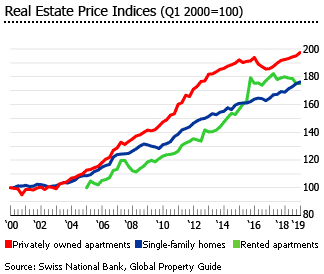
- In Zurich, the median asking price was CHF 12,820 (€11,410) per sq. m.
- In Geneva, the median asking price was CHF 12,810 (€11,402) per sq. m.
- In Lausanne, the median asking price was CHF 9,900 (€8,812) per sq. m.
- In Basel, the median asking price was CHF 8,680 (€7,726) per sq. m.
- In Berne, the median asking price was CHF 7,270 (€6,471) per sq. m.
For single-family homes:
- In Zurich, the median asking price was CHF 1.8 million (€1.6 million)
- In Geneva, the median asking price was CHF 1.67 million (€1.49 million)
- In Lausanne, the median asking price was CHF 1.39 million (€1.24 million)
- In Basel, the median asking price was CHF 1.35 million (€1.21 million)
- In Berne, the median asking price was CHF 1.2 million (€1.07 million)
Mortgage interest rates are amazingly low
In March 2019, average interest rates for newly drawn mortgage loans were:
- Variable: 2.63%, slightly up from 2.62% a year ago
- Fixed with up to 1 year maturities: 1.07%, unchanged from a year ago
- Fixed with up to 3 years maturities: 1.07%, down from 1.11% a year ago
- Fixed with up to 5 years maturities: 1.11%, down from 1.26% a year ago
- Fixed with up to 7 years maturities: 1.2%, down from 1.47% a year ago
- Fixed to 10 years: 1.41%, down from 1.72% a year ago
Despite the low interest rates, housing loans have increased only modestly over the past few years mainly because of the Federal Council’s imposition of a countercyclical capital buffer (CCB) in February 2013. From September 30, 2013 banks were required to hold 1% of all risk-weighted assets in their mortgage portfolios. As a result, mortgage interest rates started to rise in 2013, but never rose above 3%. Then in January 2014 the CCB was raised to 2%.
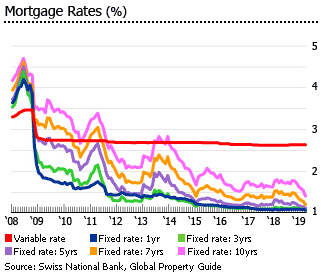
In 2014 mortgage rates fell because the central bank’s key rate was cut to a range of -0.75% to 0.25% in December 2014, as a result of SNB’s attempt to contain Swiss franc appreciation. The key rate has been unchanged since.
Swiss lenders are generally conservative. Borrowers must produce down payments of 5% to 20% of loan value. In fact, about 90% of all bank mortgages have loan-to-value (LTV) ratios of less than two-thirds of the property value.
Mortgage market remains highly leveraged
The size of Switzerland’s mortgage market was around 147.5% of GDP in 2018, far higher than the about 97% of GDP in 2000 and just 60% of GDP in 1990.
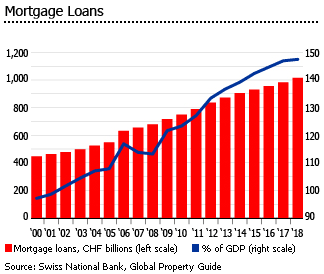
In March 2019, the total amount of mortgage loans outstanding rose by 3.44% to CHF 1.02 trillion (€910.92 billion) from the same period last year, based on figures from the SNB. Over the same period:
- Domestic: mortgage loans rose by 3.4% to CHF 1.01 trillion (€902.54 billion)
- Foreign: mortgage loans rose by 8.05% to CHF 9.42 billion (€8.38 billion)
Foreigners are settling in Switzerland in large numbers
Switzerland has one of world’s largest numbers of permanent immigrants per capita, at almost 25% of the population in 2018, according to the State Secretariat for Migration (SEM). This is significantly affecting house price movements. In 2018, net immigration was 54,763, up 3% from a year earlier, but down from an annual average of 72,000 from 2009 to 2016.
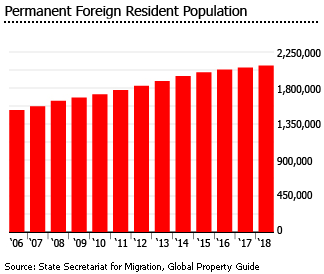
Europeans accounted for almost 86% of the permanent foreign resident population last year. Zurich has the highest number of permanent foreign residents at 19% of the total in 2018, followed by the canton of Vaud (12.5%), Geneva (8.4%), and the canton of Argovia (8%).

Foreign residents tend to remain ´foreign´, because Switzerland has one of the world’s strictest citizenship requirements. It requires 12 years of "permanent, legal, notated" residency, full integration to Swiss culture and community, and mastery of one of the official languages.
Foreign property purchases severely restricted
The Swiss have long restricted the sale of property to foreigners. Cantonal authorization is needed before gaining title. Each canton has slightly different rules and the rules even vary from commune to commune within the canton. In addition, the Federal government has set an annual quota of permits for non-resident foreigners seeking to acquire property in Switzerland.
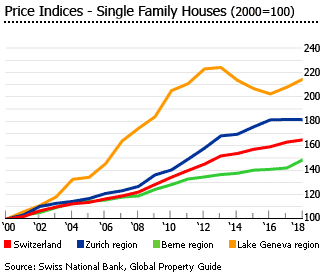
Generally speaking, foreigners have the largest choice of properties in French-speaking cantons. The most liberal canton is Vaud, which includes mountain resorts such as Villars, where foreigners can buy virtually any property and resell immediately.
Residential rents falling, amidst supply overhang
In 2018, the median asking rent for apartments fell by 2.1% from a year earlier, to CHF 190 (€169) per sq. m. per year, according to Wüest and Partner. Rents are projected to fall further by 1.5% this year, as the oversupply of rental apartments continues to weigh on the rental market.
- In Geneva, the median asking rent was CHF 360 (€320) per sq. m. per year. Geneva’s average rent in prime areas was CHF 610 (€543) per sq. m. per year.
- In Zurich, the median asking rent was CHF 320 (€285) per sq. m. per year. Zurich’s average rent in prime areas was CHF 640 (€570) per sq. m. per year.
- In Lausanne, the median asking rent was CHF 280 (€249) per sq. m. every year Lausanne’s average rent in prime areas was CHF 440 (€392) per sq. m.
- In Basel, the median asking rent was CHF 230 (€205) per sq. m. per year. Basel’s average rent in prime areas was CHF 370 (€329) per sq. m.
- In Berne, the median asking rent was CHF 230 (€205) per sq. m. per year. Berne’s average rent in prime areas was CHF 400 (€356) per sq. m. per year.
“For Switzerland as a whole, it is expected that the oversupply will maintain the pressure on advertised rents,” said Wüest and Partner.
The highest rents are in the cantons of Zug, Zurich and Schwyz, according to the Federal Statistics Office. The cheapest cantons include Jura, Neuchâtel and Glarus.
The vacancy rate for rental apartments increased to 2.6% in 2018, up from 2.3% in 2017, 2% in 2016 and 1.8% in 2015.
While the number of rental apartments on offer has increased, demand has weakened in recent years, partly due to slower population growth. In 2018, population growth fell below 1% for the first time for 11 years, compounded by the low net inward migration of foreign residents during the past three years.
Rental yields are low
Rental yields in Switzerland’s major cities are quite low. In Geneva, home to several international organizations, i.e. Red Cross, WTO, WHO and ILO, rental apartments yield from 2.8% to 3.3%, according to Global Property Guide research. Smaller apartments have higher rental yields than their larger counterparts.
Zurich, Switzerland’s biggest city and the financial capital, Global Property Guide research suggests that the gross rental yields for apartments stood at an average of 3.27%, almost unchanged from two years ago. This is supported by Wüest and Partner's recent report that in Q3, prime Zurich rental yields ranged from just 1.7% to 2.4%.
The buy-to-let market remains off-limits to foreigners, except for subsidized housing. A foreigner may only be granted authorization to acquire a rental unit if he constructs subsidized housing, i.e. builds accommodation with a rent which is low compared with similar premises in the same locality, or acquires newly built housing of the same type when there is a local housing shortage, an exception which applies only in the cantons of Fribourg, Geneva, Grisons, Jura, Neuchâtel, Ticino, Vaud and Valais.
Pro-tenant laws
Switzerland has one of the lowest owner-occupancy rates in Europe. One reason is extremely pro-tenant laws. Rent increases must be justified by the landlord’s cost increases. Tenants are also protected against eviction.
Owner-occupancy is also discouraged by taxation; property is treated as an asset subject both to wealth tax, and to income tax for imputed rental income. Income tax rates in Switzerland can easily exceed 50%, among the highest in the world. Capital gains are also taxed at cantonal level, with rates differing by duration of ownership.
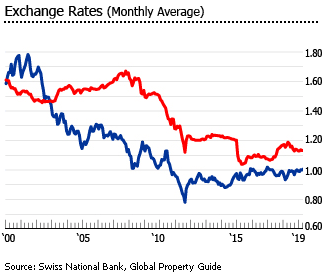
However, there has been a trend to more home ownership, which increased from 31% of the total in 1990, to about 38% recently, according to figures from the Federal Statistics Office. Changes in pension laws helped - funds can now be withdrawn for house purchases from all pension accounts, both mandatory and voluntary. However Switzerland is still sometimes dubbed ‘a nation of tenants’.
Swiss franc appreciates, as demand for safe-haven currencies rise
The Swiss franc gained 39% against the euro and almost 30% against the US dollar on January 15, 2015, when the SNB removed its CHF1.20 = EUR 1 exchange rate cap. The cap had been introduced in 2011, when investors fled the crisis-torn Euro for Swiss assets, putting pressure on exports.
However the SNB decided to abandon the cap in face of monetary easing by the European Central Bank (ECB), believing that increased demand for safe haven currencies such as the Swiss franc would make it impossible to defend the cap.
Over the past 12 months the Swiss franc has appreciated against the euro by 5%, as investors have sought safe-haven currencies, fearing that US-China trade tension will escalate. The gains partially offset the 8% depreciation of the franc against the euro in 2017.
Modest economic growth; falling unemployment
Switzerland’s economy grew by 1.7% in Q1 2019 from a year earlier, according to the State Secretariat for Economic Affairs.
The Swiss economy grew by about 2.5% last year, after growing 1.7% in 2017, 1.6% in 2016, 1.3% in 2015 and 2.5% in 2014, according to the IMF. Slow growth is due to the high franc, considered "significantly overvalued", despite record low interest rates.
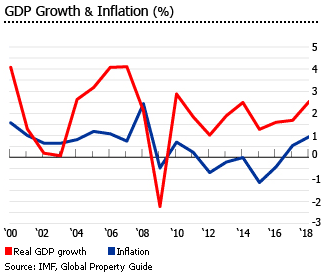
Economic growth is projected to slow to just 1.1% this year, according to International Monetary Fund (IMF.
Switzerland’s registered unemployment rate stood at 2.5% in March 2019, down from 2.9% a year earlier, according to State Secretariat for Economic Affairs, and the lowest for a decade
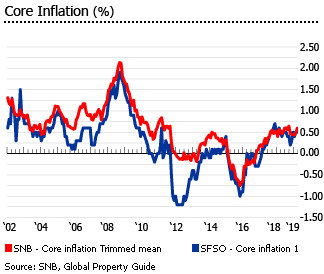
In April 2019, core inflation stood at 0.59%, according to the Swiss Federal Statistical Office. The central bank expects inflation to be around 0.3% this year and 0.6% in 2020.
Sources:
- Real estate price indices – by market area (Swiss National Bank): https://data.snb.ch/en/topics/uvo#!/cube/plimoinreg
- World Economic Outlook Database (International Monetary Fund): https://www.imf.org/external/pubs/ft/weo/2019/01/weodata/index.aspx
- Foreign exchange rates – Month (Swiss National Bank): https://data.snb.ch/en/topics/ziredev#!/cube/devkum
- Published interest rates for new transactions (Swiss National Bank): https://data.snb.ch/en/topics/ziredev#!/cube/zikrepro
- Mortgage loans and other domestic and foreign loans (Swiss National Bank): https://data.snb.ch/en/topics/banken#!/cube/bakredinausbm
- Notes – other areas of the economy (Swiss National Bank): https://data.snb.ch/en/topics/uvo#!/doc/explanations_uvo
- Consumer prices – SNB and SFSO core inflation rates (Swiss National Bank): https://data.snb.ch/en/topics/uvo#!/cube/plkoprinfla
- Net Migration Rate (Central Intelligence Agency): https://www.cia.gov/library/publications/the-world-factbook/fields/347.html
- Foreign Population and Asylum Statistics 2018 (State Secretariat for Migration): https://www.sem.admin.ch/dam/data/sem/publiservice/statistik/bestellung/auslaender-asylstatistik-2018-e.pdf
- Switzerland interest rate (Trading Economics): https://tradingeconomics.com/switzerland/interest-rate
- Poor rental yields in Geneva and Zurich (Global Property Guide): https://www.globalpropertyguide.com/Europe/Switzerland/Rental-Yields
- Property Market Switzerland 2019 (Wüest and Partner): https://www.wuestpartner.com/publications/immobilienmarkt-schweiz-2019-1?language=en
- Why Romania is a nation of homeowners, while Switzerland – a nation of tenants (Business Fondue): http://www.businessfondue.com/2018/09/07/why-romania-is-a-nation-of-homeowners-while-switzerland-a-nation-of-tenants/
- Switzerland GDP Annual Growth Rate (Trading Economics):
- https://tradingeconomics.com/switzerland/gdp-growth-annual
- Switzerland’s growth picks up as domestic demand rebounds (Financial Times): https://www.ft.com/content/f89de41c-810b-11e9-b592-5fe435b57a3b
- Swiss Economic Growth Accelerates In Q1 (ForexTV.com): https://forextv.com/forex-analysis/swiss-economic-growth-accelerates-in-q1/
- Switzerland unemployment rate (Trading Economics): https://tradingeconomics.com/switzerland/unemployment-rate
- Switzerland – Unemployment rate falls in March (SIA): https://www2.staffingindustry.com/eng/Editorial/Daily-News/Switzerland-Unemployment-rate-falls-in-March-49606